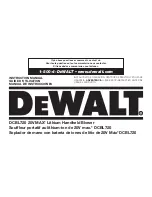
18
Installation and operation manual
–
DTH-V9-2020
Important
Start-up can only be performed by a qualified technician qualified to install gas heating
system (with accreditation) with knowledge in electricity and ventilation.
Warning
•
Do not smoke during start-up.
•
Do not try to light the burner if the gas has accumulated in combustion chamber or in
the area, if the combustion chamber is filled with vapors or if it is very hot.
1.0
Preliminary
These instructions must be followed once the ventilation unit has been started, the fan is running,
and the supply air corresponds to design criteria. All gas piping must leak tested and regulator vents
must be piped (if necessary) adequately before start-up.
-
Install a pressure gauge (0-20 in. w. c.) on the inlet pressure test port located upstream of the
low-pressure regulator. See component identification section for location.
-
Ensure that the gas inlet pressure complies with the following value:
Standard inlet pressure
Natural Gas
Propane (LP)
Minimum
7in.w.c. (1.74 kPa)
11in.w.c. (2.74 kPa)
Maximum
10in.w.c. (2.49 kPa)
14in.w.c. (3.48 kPa)
*: See gas pressure adjustment section for more details.
-
Before starting the burner and without any heating demand perform the
Fan RPM auto tuning
in the Level 2 menu of the HMI touch screen.
2.0
Pilot adjustment
-
Install a pressure gauge (0-10 in. w. c.) on the test port located on the pilot valve. See
component identification section for location.
-
Close the test firing valve and open the pilot manual gas valve.
-
Turn ON the main electrical disconnect and create a heat demand.
-
Check for pilot lighting sequence then adjust the pilot pressure written in the
Specification
section (3.5in.w.c. for natural gas, 2.5in.w.c. for propane)
.
-
Take a reading of the flame signal (4-10VDC) directly on the flame safeguard relay to be sure
the flame signal is good and stable (above 6 VDC minimum).
Start-up instruction
star
















































